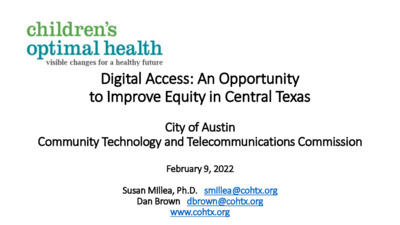Agenda Item 2a: Children's Optimal Health Data Mapping — original pdf
Backup

Digital Access: An Opportunity to Improve Equity in Central Texas City of Austin Community Technology and Telecommunications Commission February 9, 2022 Susan Millea, Ph.D. smillea@cohtx.org Dan Brown dbrown@cohtx.org www.cohtx.org Digital Inclusion and our Priority Populations “Digital inclusion is achieved through affordable, robust internet services, digital literacy skills, quality technical support, access to hardware and software, and opportunities for resources and services that augment inclusion efforts.” Texas State Libraries and Archives Commission Goals for Today: • Demonstrate how to access and navigate the website • Describe our Digital Inclusion project and findings • Demonstrate our interactive mapping tools (Live demo if time allows) • Discuss a call to action to advance digital equity Goals for Today: • Demonstrate how to access and navigate the website • Describe our Digital Inclusion project and findings • Demonstrate our interactive mapping tools • Discuss a call to action to advance digital equity COH Digital Inclusion Project • May 2020: disparities in digital tech access impeding student learning • Good Measure Grant • 5 County Metro Area • Food security, Health/Mental health, Social Services • Scope expanded: health providers, those serving aging populations • Work across sectors • GTOPS grants • Many, many partners involved! www.cohtx.org www.cohtx.org www.cohtx.org www.cohtx.org www.cohtx.org COVID-19, SDOH, Digital Access, and Equity y t i l i i b a n a t s u S Adapted from Toronto, Canada What we are learning from Priority Populations: DIVERSITY What is your race or origin? What is your ZIP Code? Has your household struggled to meet basic needs in SY 2020-21? What we are learning from Priority Populations: ACCESS Has a lack of good internet access or devices in your home caused problems obtaining any of the following? Same question, analyzed by Race/Ethnicity What we are learning from Priority Populations: DEVICES Devices used in household, by Count of Respondents Devices used in household, by Count of Devices What we are learning from Priority Populations: CONNECTIVITY How important is high-speed internet access at home? If low-cost high-speed internet were available at home, realistically what is the most per month you could afford to pay? How do you access the internet from home? Using Interactive Maps: Overview Using Interactive Maps: Poverty Concentration by Council District Income and Poverty: % Below the Poverty Level Using Interactive Maps: Computing Devices by Council District Households with one or more computing devices Households with ONLY a smartphone Using Interactive Maps: Internet Access by Council District Households with Internet access and NO SUBSCRIPTION Households with NO INTERNET ACCESS Conclusions Digital equity is emerging as a ‘super-determinant’ of health • Digital equity for education is essential for our priority populations • Impact of failure to ensure digital inclusion is multigenerational, with economic and health effects • Digital access for health is essential for our priority populations • Health and social service providers need to screen for devices, internet access, skills, affordability • Smartphones are ubiquitous even among many within our priority populations • Who “owns” responsibility for digital inclusion? • Cross-sector issue • High risk of a return to silo-ing post pandemic • Policies to enhance digital equity are being developed now • Funding opportunities for digital access are now, equity efforts need to be integrated Texas Statewide Recommendations Planning for Digital Inclusion in Texas UT School of Law Texas Black Caucus Foundation and Civil Rights Clinic Texas Communities Need All Texans Need • Access to affordable and reliable high-speed broadband • Access to internet-enabled devices • Access to digital literacy training • Access to technical support Texas Statewide Recommendations Planning for Digital Inclusion in Texas UT School of Law Texas Black Caucus Foundation and Civil Rights Clinic All Texans Need • Access to affordable and reliable Texas Communities Need • Improved data collection and high-speed broadband analysis • Access to internet-enabled • Grants/funding to local devices communities • Access to digital literacy training • Access to technical support • Public-private partnerships to advance digital inclusion Local Call to Action • Austin should be a national leader for digital inclusion and equity. • Entities already working on Diversity/Equity/Inclusion should incorporate digital equity within that scope. • Entities serving people adversely affected by SDOH should screen and monitor client needs for digital access. • To be competitive for investment, gather local data on broadband access, reliability, speed testing. • Develop the capacity to assess local needs by engaging members of priority populations. • Local governments and anchor institutions (school districts, health and social service systems, libraries) should collaborate across sectors and work with and support the TX Broadband Development Office. • Trusted digital navigators with language and cultural competence are essential support for those with less access. They need funding. • Technology will evolve. Achieving digital equity is an on-going process. • Develop metrics, track, and report progress. Document challenges. Thank You Susan Millea and Dan Brown www.cohtx.org Mapping Demo (if time allows) Q/A and Discussion